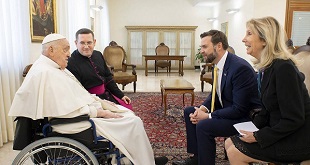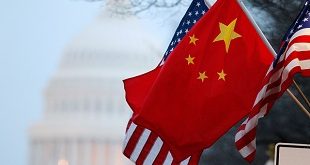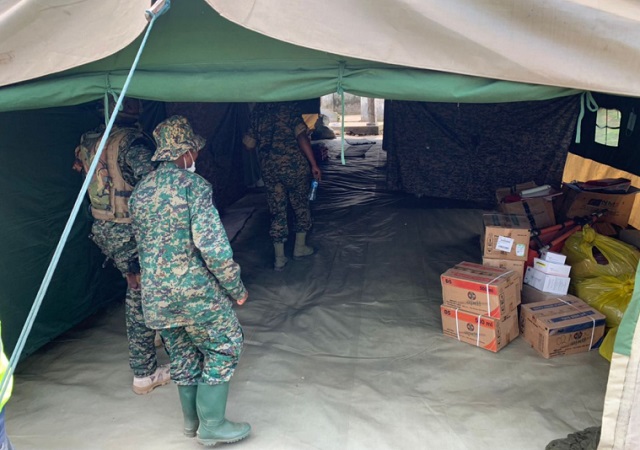
With a limited mandate, logistical nightmares, and political posturing, is Ugandan army on mission impossible against ADF?
NEWS ANALYSIS | KWEZI TABARO | It is morning on Jan. 07 and we are seated on the terrace of Gardens Restaurant, a popular stop-over for many travelers to Fort Portal town in Rwenzori region, western Uganda, and beyond.
Barely a month earlier, on November 30, Ugandan forces (UPDF) and DR Congo forces (FARDC) had launched a joint attack on the camps of the Allied Democratic Forces (ADF). An artillery and air bombing campaign was followed by a joint ground assault targeting ADF camps in Eastern Congo.
But many questions surround the mission codenamed Operation Shujaa – Swahili for bravery. On this trip to the frontlines in eastern DR Congo, I hope to put these questions to UPDF commanders.
As NTV’s Raymond Mujuni and I await our order—two African coffees packed to go- and Gardens Restaurant, an old jewel of Fort Portal town, its relative quietness and empty tables belie its mid-to-late 1990s reputation as a popular meeting point for the town’s elite, aid workers, journalists, and army generals.
This was the time Rwenzori region was a hotbed of ADF terrorism and a retelling of a dramatic encounter at the same restaurant by veteran journalist and Tooro native Patrick Kamara comes to mind.
As Kamara narrated in his `Museveni’s Warriors’ series for the Independent, one memorable Friday evening, he had run into friends at Gardens Restaurant and they were sipping a few drinks well into the night.
“Then, just after midnight, we had an unusual guest; the national Army Chief of Staff himself – Brig. James Kazini,” recalls Kamara.
The bubbly—if occasionally, reckless—Kazini ordered his bodyguards to seal off all exits to the restaurant and bar; asked for his favourite Uganda Waragi gin and set up a “tactical base” at the restaurant where rebel “collaborators” of ADF were brought in for interrogation one by one. The questioning was led by none other than Kazini himself.
This was the 90s and a lot has changed today: the UPDF command has been systematically trimmed of mavericks like Kazini who died in 2009. The new crop of commanders, younger—most in their 40s, educated, and exposed to trainings from some of the best military academies in the world, would possibly not set up a tactical base in a popular restaurant.
Gardens Restaurant too has lost its magnetic attraction to newer establishments that now dot this quiet tourist city at the foot of the Rwenzori Mountains near the Uganda DR Congo border.
We are waiting to enter DR Congo on a guided trip with Operation Shujaa commander, Maj Gen. Kayanja Muhanga, and I notice that even the road that snakes through steep mountain sides to connect Fort Portal to neighbouring Bundibugyo town and DR Congo, which used to be murram, was tarmacked in 2010.
My reverie ends with the arrival of a soldier who goes by the moniker “Commando”. He is the military assistant of Operation Shujaa commander, Maj Gen. Kayanja Muhanga.
“Don’t wait for the General, you can proceed now,” he barks, “We shall find you at the border crossing. We have a convoy there!”
Commando has arrived in one of Gen. Kayanja’s escort vehicles; a Toyota Land Cruiser 79 series. This type of vehicle is such a favoured “beast of burden” for many African armies that it even has a war named after it, the so-called “Toyota War” between Chadian and Libyan forces in 1986-87, in which the former inflicted a heavy defeat against Colonel Gaddafi’s army thanks in part to the mobility offered by these famed Toyota pickups.
With the rising sun behind us, we set off for Busunga, a border town located about 100kms away on the Fort Portal – Bundibugyo – Lamia road.
Gen. Kayanja’s convoy, accompanied by a team of engineers from the national roads authority UNRA, catches up with us as we enter Bundibugyo town. Bundibugyo town today is bustling with business. Its streets are paved and as we drive to the border the road narrows as its sides are lined by parked trucks ferrying merchandise ranging from cocoa to plastics and cement.
We descend to Busunga border crossing, driving through cocoa plantations interspersed by banana plantations that stretch all the way into the mountains.
It is hard to imagine this was the same town that 21 years ago, at the onset of the ADF insurgency, was beset by over 100,000 refugees. As described by one WFP official in 1999, “all around Bundibugyo abandoned cocoa trees and other lucrative cash crops are turning wild”.
Today, Bundibugyo district is peaceful and produces over 70% of Uganda’s cocoa exports. “The biggest threat that place faces now are high food prices. Farmers have abandoned food crops for cocoa,” Johncation Muhindo, a community organizer tells me over breakfast in Kasese the following day.
At the URA customs checkpoint at the border, a police officer lifts the barrier and we drive a few metres into what should be “no man’s land”. Here, a football playfield has been turned into a temporary parking yard for the Ugandan army. UPDF troop carrier trucks, locally assembled “Nyoka” 4×4 APCs, an ambulance and a number of water trucks are revving their engines as they await orders to form a convoy.
Our NTV press car cannot go beyond this point. There could be ambushes ahead, Gen. Kayanja tells us. We must travel in one of the armoured personnel carriers (APCs). As we make our way to the vehicle, I ask Kayanja what UPDF’s objectives for the operation are.
“The operational end state is to degrade the ADF’s means of making war,” he tells me, “While our strategic end state is to create a conducive environment for trade between Uganda and DR Congo.”
There will be more answers to come but for now time is running out. Its approaching midday and we are supposed to drive at least 40kms into Congo to reach the UPDF’s PK51 camp, the last forward operating base before you reach ADF’s Kambi ya Yua tactical which was captured by UPDF.
At 12:15 our convoy of four APCs sandwiching a military ambulance, two water trucks, two troop carrier trucks as well as a Hizir APC in which is seated Gen Kayanja crosses the Busunga bridge into the DRC. The Turkish-made Hizir belong to a family of MRAP (Mine Resistant Ambush Protected) APCs.
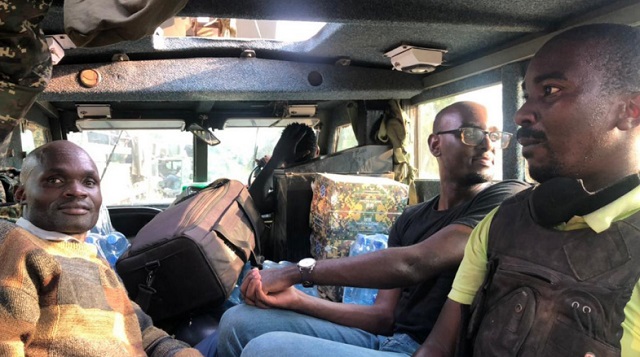
Inside Congo
Everything feels different on the DR Congo side of the border. The smooth tarmac road on which we had been driving for the last two-and-a-half hours abruptly gave way to a rugged trail. The seats in the 10-seater “Nyoka” APC—not the most comfortable even on a good road—now felt even more uncomfortable with each obstacle we encountered. Our knees knocking against one another, I make quick acquaintances with the UPDF soldiers in our APC which is at the tail end of the convoy. Seated across me is Alfred, a lieutenant from the Special Forces. One of the two gunners is Alex from Motorized Infantry, and the other Emmanuel. “I am Saddick Saad,” a voice shouts over the noise from the running engine. He is our driver.
Fifteen minutes into our drive the convoy comes to an abrupt stop as we pass through the Congolese town of Nobili. At first we cannot tell why the vehicles have stopped until, over the radio, we hear that one of the two water trucks in our convoy has gotten stuck in a ditch.
“It is dangerous for the convoy to stop in such instances,” Alfred, the lieutenant from Special Forces tells me. “The enemy can attack any time”.
Soldiers in the other trucks disembark to assist the stuck truck. But with little progress, we are losing time and it is coming to 1:30pm Ugandan time (12:30pm in Congo since the country is one hour behind).
Unable to stay put in the mid-afternoon heat the doors to our APC are flung open and Saad, the driver, offers to escort me to the nearby shops so I can interview some Congolese business people.
In terms of size, Nobili is possibly three to four times the size of Bundibugyo town. But that is as far as comparisons go. For a town its size, it does not have access to electricity, there are no petrol stations, no clean water, and no road infrastructure to talk about.
The business atmosphere however is vibrant. Motorcycles are the major means of transport in this town, ferrying both goods and passengers into Nobili and beyond. There are many of them but almost none bears a number plate. Mini petrol “stations” dot every shop corner to supply local fuel needs. The setup is minimalist: a wooden stand, one- and two-litre water bottles filled to the brim with the reddish flammable liquid, and usually a woman attendant.
Saad greets one of the shop attendants selling “Kitenge” fabric as we enter her corner shop.
“In the last month since UPDF entered here things have been better,” she tells me in Kiswahili. She however expresses worry about the wider insecurity as ADF rebels are dispersed from their camps by UPDF and FARDC forces. She says a few days before our visit, two people—a businesswoman married to a FARDC soldier and her motorcycle rider, had been killed while on their way to Oicha, a town about 90kms from the Ugandan border. The ADF rebels also burned the motorcycle. The businesswoman’s daughter escaped into the bushes and was rescued by FARDC and UPDF forces.
After a 30 minute wait the order is given for the convoy to proceed to the Mukakati, the last camp before while a company of soldiers is left behind to guard the water tank.
Camp Mukakati
Mukakati was the UPDF’s first defensive position in the Congo. It is located just 20 kilometers from the Ugandan border but it took the UPDF over 12 hours to reach it, Alfred tells me.
To reach Mukakati we drive through vast expanses of forest, remote villages along dirt path, and the town of Kamango.
Along the way, civilians cheer and wave at the UPDF convoy, children line the roads, hands spread out. The convoy occasionally slows down and soldiers throw out biscuits and sweets to the jolly youngsters. It is only when we are nearing Kamango that one notices the presence of FARDC, the Congolese national army.
The section between Kamango and Camp Mukakati is patrolled by columns of UPDF and FARDC soldiers; two paired every hundred or so metres. On top of patrolling the route to detect ADF ambushes, the columns also offer protection to a road construction unit clearing vast expanses of jungle to create supply lines to UPDF/FARDC position. The unforgiving heat and humidity has taken a toll on many of these soldiers and our convoy stops a few times to replenish their water supply with UPDF’s Uzima bottled water.
The UPDF commanders tell us it is expensive to transport water this far into the operations area but they have limited options.
“I have carried along these engineers to prospect for water sources around Mukakati camp,” Kayanja tells us. The camp has a generator and pipes that have been delivered recently.
Mukakati camp is a huge clearing on the edge of a vast forest whose edges are lined by deep ravines. The UPDF forces arrived here on December 1, a few days after Operation Shujaa was launched.
“There was nothing here before we came,” recalls Kayanja as he shows us around the camp.
The camp has a well-stocked forward operating base (FOB) hospital comparable to a Ugandan Health Centre IV level that offers treatment to both civilians and UPDF/ FARDC soldiers.
The field medical officer, Capt. Dr. Raymond Agaba, they mainly register sanitation-related diseases among the civilian population and combat injuries for the soldiers.
“Since we came here, we have also registered some 10 Covid cases,” he tells us. For the local population around Mukakati, this is the first time a facility is screening for Covid and offering guidance on Standard Operating Procedures (SOPs) to avoid the disease.
We have only a limited time at Mukakati since our convoy is also carrying supplies for the next destination, camp PK51.
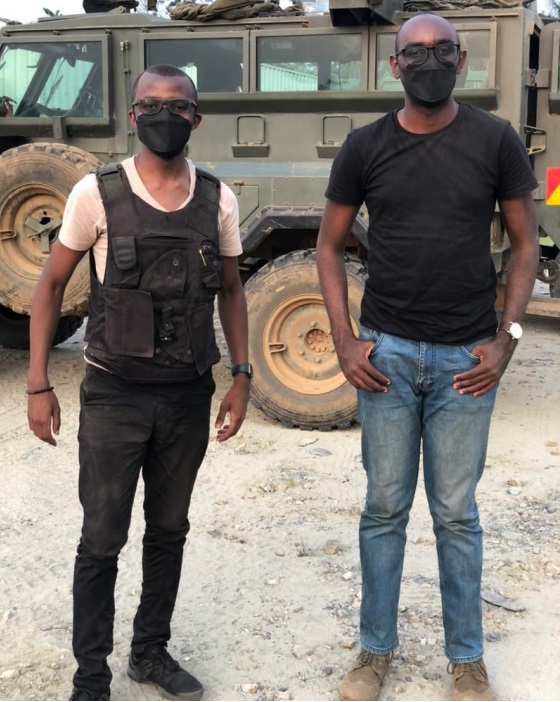
The Triangle of Death
Before we leave, Gen Kayanja leads us to his quarters where a giant map is pinned on the wall. It describes Operation Shujaa’s operational zone—what he calls ADF’s “triangle of death” measuring 170kms by 110kms. In relative size the operational zone, separated into three sectors, is at least 50 times the size of Kampala district and straddles the Congolese provinces of Ituri and North Kivu.
And this is the UPDF’s biggest challenge so far: The Congolese authorities have allowed Uganda to deploy only 2000 soldiers to cover this vast span of forest with no clear supply lines.
“We had wanted at least a division—between 7,000 to 20,000 soldiers—to enter here,” says Gen. Kayanja, himself a veteran of Uganda’s last lengthy campaign in the Congo from 1998-2003.
The UPDF’s mission is also due for review by the Congolese authorities next month, and thereafter every two months. This presents a challenge to the UPDF and Kampala since it leaves the mission’s fate at the mercy of mainly opposition politicians in Kinshasa who, eyeing an election next year, are keen to play up nationalist sentiment and force Tshisekedi’s government to walk back from the cooperation agreement with Uganda.
Leading opposition figure Martin Fayulu who was runner up to Tshisekedi in the disputed 2018 election, used his end of year speech last month to slam the presence of Ugandan troops on Congolese soil. He said Kinshasa was sub-contracting the security of the state to foreigners. The ADF are also believed to have collaborators within MONUSCO and the FARDC itself.
Meanwhile, as with previous campaigns, the government did not seek parliamentary approval to send troops abroad as required under the Constitution. The Minister of State for Foreign Affairs, Okello Oryem, explained that the country “needed the element of surprise in order to deal with the terrorists effectively”.
But some Ugandans too remain wary of past misadventures in their giant neighbour’s back yard that resulted in a U$4.3 billion reparations claim by Congo at the International Court for Justice.
These sentiments, borne in faraway capitals of Kinshasa and Kampala, have a bearing on the population of eastern DRC have to contend with insecurity and the possibility of revenge attacks from ADF if UPDF withdraws.
Camp PK51
The distance between Mukakati and PK51 is roughly 17 kilometres. But it took UPDF another 10 days to cover. For us, the trip takes roughly an hour. The terrain is bad. We are forced to walk the last three kilometres uphill after our convoy is told we cannot use the Semliki Bridge crossing which separates North Kivu and Ituri. It had been damaged a week earlier by crossing UPDF tanks and now posed the risk of caving in.
The UNRA engineers in our convoy assess whether temporary repairs are possible but their verdict does not amuse the operational commanders.
“The reinforcing bars are weak,” one of the UNRA engineers says and adds that, if the UPDF must continue using the bridge, they must limit traffic to one light vehicle at a time. Asked how long it would take to construct a new bridge, the engineers are at first hesitant and then suggest between 12-18 months. The UPDF operational commanders have one option left: to use barges to ferry supplies across the river.
Unlike Mukakati, camp PK51 is located on elevated ground and overlooks vast forest. Freshly dug fox holes surround the camp as defensive positions in case of any attack. Supplies—new pairs of uniform, food, water, and dry rations—from our convoy are unloaded and the camp’s commander briefs us on the mission’s progress.
It is from this camp that the ground offensive on Kambi ya Yua was launched two weeks ago. Although the ADF camp was only 10 kilometres away it took the UPDF roughly 10 days on foot to reach Kambi ya Yua owing to difficult terrain—thick forests, rivers, ridges and the unforgiving jungle heat.
“We could not take the tracks used by ADF because they may be mined,” Gen Kayanja tells us.
This is partly why by the time the UPDF reached Kambi ya Yua, it had been evacuated. However, the army recovered some important documents that detailed the ADF’s supply routes and the number of people who were inhabiting the camp—around 620 families.
It is coming to 4pm local time when our convoy begins the return journey, first to Mukakati for a brief stopover and all the way back to Busunga before sunset. I turn to Alfred, the Special Forces lieutenant we have been moving with for most of the day and ask him why he thinks UPDF will succeed where MONUSCO and the Congolese FARDC have failed so far.
“Our doctrine is different. It shows in the way we dress, conduct operations and how we interact with the population.”
We part at camp Mukakati but Alfred’s answer is running through my mind as we make a hasty return trip to Ugandan soil before 6pm.
We reach Busunga at 6:30pm Ugandan time. Covered in dust from head to toe, we quickly disembark from the APCs. The commander orders a fall in for his troops at this newly converted football field. Across the Busunga bridge on the Congolese side locals marching back home disappear into the setting sun.
It is time to get back into our NTV press car and begin the journey to Fort Portal. Only two decades ago, a trip like this, past sunset, would be ill-advised. What with the dangerously hanging cliffs that characterize the Bundibugyo-Fort Portal route. But more frightening would be the possibility of an ADF ambush. Such fears seem farfetched in Uganda today, but they are only too real just across the border in Congo.
My mind rushes to the hundreds of young Congolese children who had line the dirt roads there. What does the future hold for them? For how long will this giant neighbour’s insecurity stunt not just their bodies but their futures as well? For how long will the UPDF stay here? There are no easy answers.
The UPDF’s conduct in the Congo today is in many ways an embodiment of the tremendous change that Uganda’s institutions have undergone in the last few decades. While operation Shujaa’s mission’s success remains encumbered by many factors beyond the control of the army itself—let alone Uganda, no matter the outcome, the best gift Uganda can bequeath its giant neighbour today is the power of example.

****
 The Independent Uganda: You get the Truth we Pay the Price
The Independent Uganda: You get the Truth we Pay the Price

